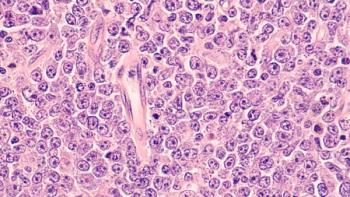
Trastuzumab Deruxtecan Provides Long-Term Survival Benefit for HER2+ Metastatic Breast Cancer
Compared with physician’s choice of treatment, trastuzumab deruxtecan exhibited superior long-term survival and response rates in patients with HER2-positive breast cancer.
Fam-trastuzumab deruxtecan-nxki (T-DXd; Enhertu) continued to show clinically meaningful efficacy improvements and manageable toxicities compared with treatment of physician’s choice (TPC) in patients with HER2-positive metastatic breast cancer who progressed on ado-trastuzumab emtansine (Kadcyla; T-DM1), according to long-term follow-up data from the phase 3 DESTINY-Breast02 trial (NCT03523585).1
These updated results, which reinforce the agent’s favorable risk-benefit profile in this population, were presented during the 2024 ESMO Breast Cancer Annual Congress.
At a median follow-up of 26.8 months, patients treated with T-DXd experienced a median overall survival (OS) of 35.7 months (95% CI 30.9-40.8) compared with 25.0 months (95% CI, 20.4-31.5) in patients who received TPC. This translates to a 31% reduction in the risk of death with T-DXd vs TPC (HR, 0.69; 95% CI, 0.55-0.86). The 24-month OS rate was 64.6% (95% CI, 59.6%-69.2%) with T-DXd vs 51.9% (95% CI, 44.4%-58.9%) with TPC; the 36-month OS rates in these respective arms were 49.2% (95% CI, 44.0%-54.3%) and 36.6% (95% CI, 29.5%-43.8%).
“With longer follow-up, [these] results reinforce the substantial benefit of T-DXd over TPC in patients with HER2-positive metastatic breast cancer previously treated with T-DM1,” lead study author Sung-Bae Kim, MD, PhD, a professor at Asan Medical Center, University of Ulsan in Seoul, Korea, explained in an oral presentation.
T-DXd also produced a confirmed investigator-assessed overall response rate (ORR) of 74.1%, including a complete response (CR) rate of 8.6%. Stable disease (SD) was achieved by 20.9% of patients, 3.4% of patients experienced progressive disease (PD), and 1.5% of patients were not evaluable (NE). In contrast, the confirmed ORR in the TPC group was 27.2%, with 2.0% of patients experiencing a CR. Almost half (48.5%) of patients achieved SD, 13.9% of patients experienced PD, and 10.4% of patients were NE. The median duration of response (DOR) per investigator assessment was 19.1 months (95% CI, 15.2-25.1) with T-DXd and 6.3 months (95% CI, 5.1-8.1) with TPC.
Additionally, the median progression-free survival (PFS) by investigator assessment in the T-DXd arm was 16.7 months (95% CI, 14.7-19.6) compared with 5.5 months (95% CI, 4.4-6.8) in the TPC arm (HR, 0.30; 95% CI, 0.24-0.37). The 24-month PFS rates in the T-DXd and TPC arms were 38.5% (95% CI, 33.1%-43.8%) and 7.0% (95% CI, 3.6%-12.0%), respectively; at 36 months, the PFS rates in these respective arms were 31.4 months (95% CI, 26.2%-36.8%) and 4.0% (95% CI, 1.5%-8.7%).
DESTINY-Breast02 was an open-label, multicenter, randomized study comparing the efficacy and safety of T-DXd vs TPC in patients with centrally confirmed HER2-positive, unresectable or metastatic breast cancer with prior exposure to T-DM1. HER2 positivity was defined as an immunohistochemistry score of 3+ or 2+ with a positive in situ hybridization test. Documented radiographic progression after a patient’s most recent treatment was also required.
Patients were stratified by hormone receptor status, prior treatment with pertuzumab (Perjeta), and history of visceral disease. A total of 608 patients were enrolled onto the trial and randomly assigned 2:1 to receive 5.4 mg/kg of T-DXd every 3 weeks (n = 406) or TPC per label (n = 202), which was capecitabine plus either trastuzumab (Herceptin) or lapatinib (Tykerb).
The trial’s primary end point was PFS by blinded independent central review (BICR), with OS as a key secondary end point. Other secondary end points included ORR and DOR by BICR; ORR, DOR, and PFS by investigator assessment; and safety. Time from randomization to progression on second-line therapy (PFS2) served as an exploratory end point. End points for the current data cutoff were evaluated per investigator assessment, as BICR was discontinued after the primary analysis, Kim noted during the presentation. Baseline characteristics were well balanced between treatment arms, which was consistent with prior reports. The median duration of follow-up was 30.2 months (range, 0.8-60.7) in the T-DXd arm and 20.5 months (range, 0.0-60.6) in the TPC arm.
Previously reported data from the primary analysis of DESTINY-Breast02 demonstrated a statistically significant and clinically meaningful PFS and OS benefit with T-DXd vs TPC.2 At a median follow-up of 21.5 months (IQR, 15.2-28.4) in the T-DXd arm and 18.6 months (IQR, 8.8-26.0) in the control arm, the median PFS was 17.8 months (95% CI, 14.3-20.8) with T-DXd vs 6.9 months (95% CI, 5.5-8.4) with TPC (HR, 0.36; 95% CI, 0.28-0.45; P < .0001).Moreover, T-DXd generated a median OS of 39.2 months vs 26.5 months with TPC (HR, 0.66; 95% CI, 0.50-0.86; P = .0021).1,2
In the current analysis, 0.5% and 3.5% of patients who were randomly assigned to treatment with T-DXd or TPC, respectively, did not receive their assigned treatment.1 The median treatment duration was 11.3 months (range, 0.7-60.7) vs approximately 4.5 months (range, 0.1-50.6) in these respective arms. All patients discontinued treatment in the TPC arm vs 86.4% of patients in the T-DXd arm. Reasons for treatment discontinuation included PD (47.8% with T-DXd; 73.8% with TPC), adverse effects (AEs; 20.3%; 7.2%), patient withdrawal (9.2%; 8.7%), clinical progression (6.4%; 8.7%), death (1.2%; 0.5%), loss to follow-up (0.5%; 0.0%), physician’s decision (0.5%; 0.5%), protocol deviation (0.2%; 0.5%), and other reasons (0.2%; 0.0%). At data cutoff, treatment was ongoing in 13.6% of patients in the T-DXd arm and no patients in the TPC arm.
Among patients who discontinued T-DXd (86.0%) and TPC (96.5%), respectively, 70.8% and 75.9% went on to receive post-trial systemic treatment. Patients also went on to receive radiation therapy (12.3%; 12.8%) or surgery (2.9%; 3.6%). Kim added that 13.0% of patients in the T-DXd arm and 46.6% of those in the TPC arm received T-DXd as their post-trial therapy.
A total of 48.0% and 60.9% of patients experienced PFS2 in the T-DXd and TPC arms, respectively. The median PFS2 was 33.0 months (95% CI, 28.6-36.6) and 15.0 months (95% CI, 13.0-18.1) in these respective arms (HR, 0.42; 0.33-0.53).
Regarding safety outcomes, Kim stated that, “The safety profile of T-DXd continues to be manageable, with no long-term toxicity observed with longer follow-up.”
Any-grade, drug-related treatment-emergent AEs (TEAEs) were reported in 97.5% and 92.3% of patients in the T-DXd and TPC arms, respectively. The most common TEAEs in the T-DXd arm were nausea (72.5%), fatigue (62.4%), and vomiting (38.1%). Common TEAEs observed in the TPC arm included diarrhea (53.8%), palmar-plantar erythrodysesthesia syndrome (51.3%), and nausea (37.4%). Grade 3 or higher TEAEs were observed in 42.8% and 31.3% of patients in the T-DXd and TPC arms, respectively. The incidence of serious drug-related TEAEs was 11.6% and 7.7% in these respective arms. Drug-related TEAEs did result in treatment discontinuation (15.6%; 5.1%), drug interruptions (33.7%; 39.0%), and dose reductions (25.7%; 46.2%) across arms. No new drug-related TEAEs associated with death have been observed since the primary analysis.
With the extended data cutoff, rates of interstitial lung disease (ILD) or pneumonitis increased from 10.4% to 11.4% in the T-DXd arm. Moreover, 4 novel grade 1/2 adjudicated drug-related ILD/pneumonitis events were noted with T-DXd. However, Kim emphasized that a longer duration of treatment with T-DXd was not associated with an increased risk of ILD/pneumonitis; most any-grade events (8.2%) were reported within 12 months of treatment initiation.
Disclosures: Dr Kim reports serving in consulting or advisory roles for Novartis, AstraZeneca, Lilly, DaeHwa Pharma, ISU Abxis, Daiichi Sankyo, Ensol Bioscience Inc, BeiGene, and OBI pharma; receiving institutional research funding from Novartis and Sanofi-Aventis; and ownership of stock or shares in Genopeaks and Neogene TC.
References
- Kim SB, André F, Takano T, et al. Trastuzumab deruxtecan (T-DXd) vs treatment of physician’s choice (TPC) in patients (pts) with HER2+ metastatic breast cancer (mBC) previously treated with trastuzumab emtansine (T-DM1): updated overall survival (OS) results of the randomized phase III DESTINY-breast (DB-)02 study. Presented at: 2024 ESMO Breast Cancer Annual Congress; May 15-17, 2024; Berlin, Germany. Abstract 182O.
- André F, Park YH, Kim SB, et al. Trastuzumab deruxtecan versus treatment of physician’s choice in patients with HER2-positive metastatic breast cancer (DESTINY-Breast02): a randomised, open-label, multicentre, phase 3 trial. Lancet. 2023;401(10390):1773-1785. doi:10.1016/S0140-6736(23)00725-0


















































































